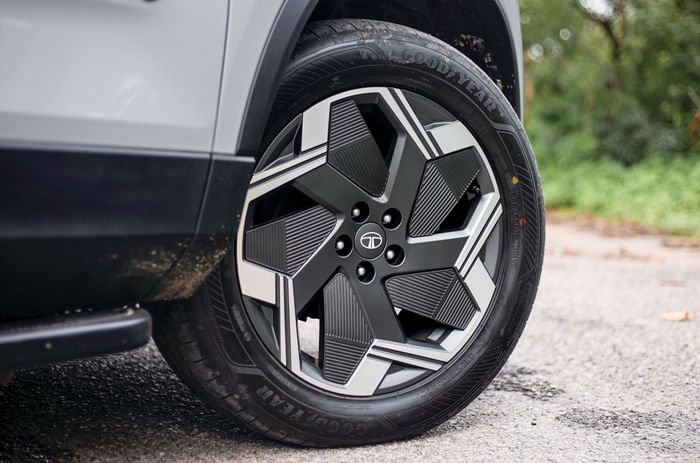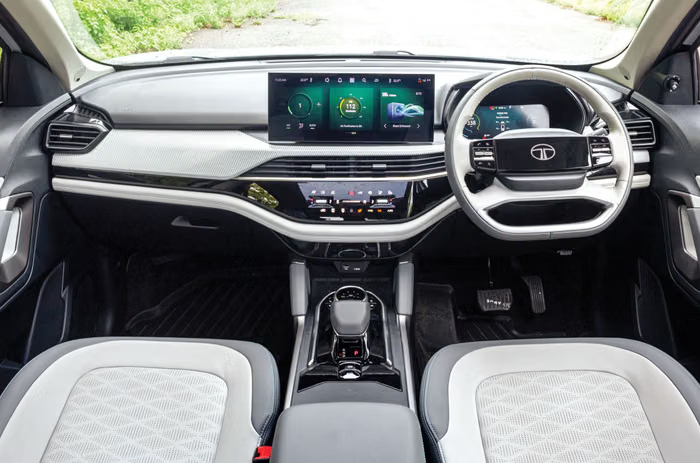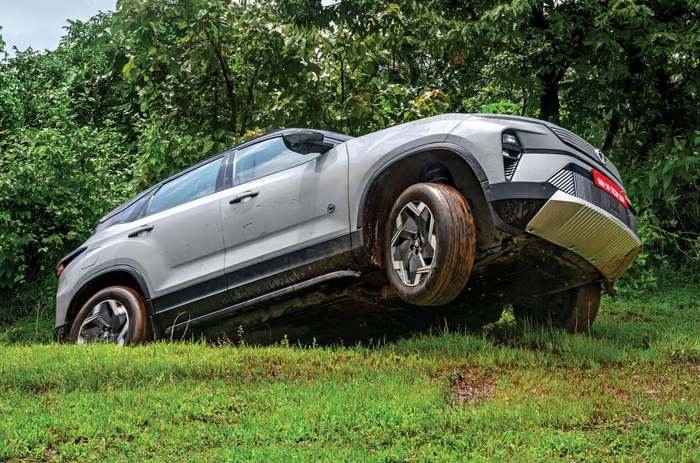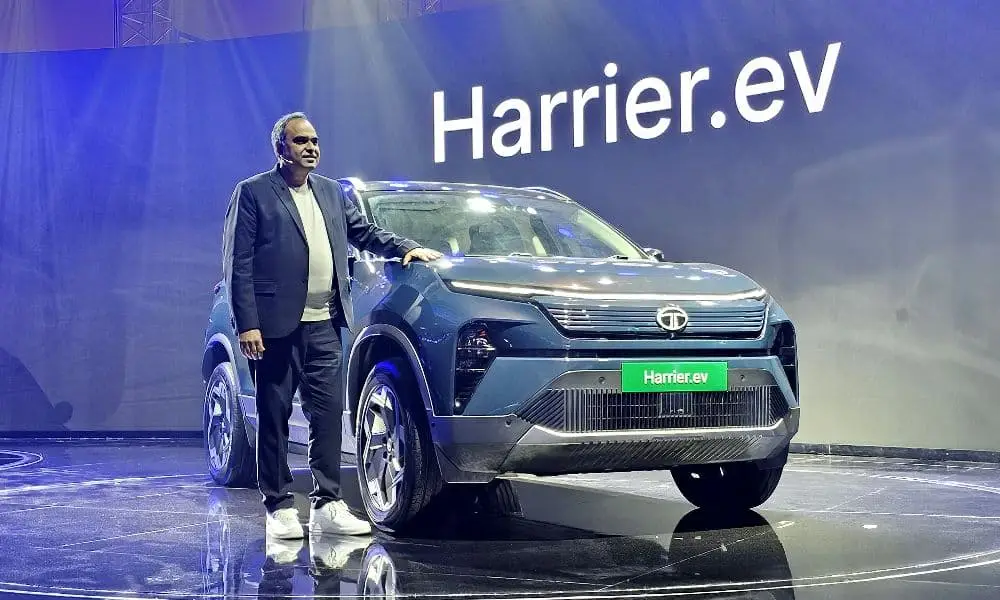The Tata Harrier EV is praised for its smooth, powerful, and quiet driving experience, with strong acceleration, especially in sport mode, and good off-roading capability due to its quad-wheel-drive tech.
Driving experience
- Performance: The Harrier EV is described as a powerful and fun-to-drive SUV, with excellent acceleration. The 75 kWh variant with dual motors is powerful, achieving
0−1000 minus 1000−100 km/h in approximately
6.36.36.3 seconds.
- Handling: It offers well-contained body roll and a stable, planted feel, even during spirited cornering. The all-wheel-drive system provides excellent grip.
- Ride Quality: The new independent rear suspension provides a plush and comfortable ride, effectively absorbing road imperfections, though sharp potholes can be noticeable.
- Braking: All-disc brakes are effective, providing strong stopping power and confidence, though one review notes it’s an area for potential improvement.
- Noise: The car is very quiet, with the only significant noise being wind noise at higher speeds.
The Tata Harrier EV is a strong contender in the electric SUV segment, praised for its commanding performance, plush ride, and extensive list of modern features. Built on Tata’s new Acti.ev+ platform, it moves beyond a simple ICE-to-EV conversion and feels like a mature, well-engineered electric flagship.
ata Harrier EV exterior design and engineering – 7/10
Familiar looks and a completely re-engineered chassis to accommodate the EV powertrain.

Larger 19-inch alloys look smart and low-speed ride quality is good despite their size. Lower variants get 18-inch rims with higher-profile sidewalls.
Range and charging
The Harrier EV is offered with two battery options, providing respectable real-world range and decent charging times.
Battery and range options:
- 65 kWh battery pack: Offers a claimed range of 538 km (MIDC). In real-world mixed usage, drivers can expect around 400-420 km.
- 75 kWh battery pack: Provides a claimed range of 627 km for the rear-wheel-drive version and 622 km for the all-wheel-drive (QWD) version. Real-world mixed usage is closer to 450-500 km.
Charging capability:
- AC charging: A 7.2 kW home wallbox charger takes about 10 hours for a full charge.
- DC fast charging: Can charge from 20–80% in approximately 25 minutes using a 120 kW (or higher) DC fast charger.
- Vehicle-to-Load (V2L) and Vehicle-to-Vehicle (V2V): The EV can supply power to external devices and charge other compatible electric vehicles.
Tata Harrier EV interior space and comfort – 7/10
Spacious and a hugely appealing interior, but it has some ergonomic flaws.
The cabin borrows heavily from the ICE Harrier. Dual-tone upholstery enhances the sense of space, while glossy piano black trims lend richness – though they are prone to scratches and smudges. The steering wheel is chunky, with a gloss-black boss and an illuminated Tata logo adding flair.

Tata Harrier EV features and safety – 9/10
Packs several clever and fascinating features, which will appeal to tech-savvy buyers.
Tata’s acti.ev+ platform forms the backbone of the Harrier EV’s connected tech and advanced driver assistance systems (ADAS). At the centre of the cabin is a 14.5-inch Samsung Neo QLED touchscreen, which is crisp, responsive and easy to navigate. Its uncluttered interface, coupled with wireless Android Auto and Apple CarPlay, makes smartphone integration seamless. The system also comes with Mappls (MapMyIndia) in-built navigation and Alexa voice assistant. Audio quality is a step up from the ICE version, thanks to the 10-speaker JBL Black system with Dolby Atmos, which delivers an immersive sound experience.
The Harrier EV is available with two battery options – 64.7kWh and 74.61kWh; both are lithium-ion batteries with Lithium Ferrous Phosphate (LFP) cell chemistry. Unlike its ICE counterpart, which is front-wheel driven, the Harrier EV is primarily rear-wheel driven, powered by a permanent magnet synchronous motor, which makes 238hp and 315Nm of torque. The bigger-battery version also gets a dual-motor option, which includes an induction motor producing 158hp and 164Nm driving the front wheels. Combined, the two motors powering the Harrier EV QWD (Quad Wheel Drive), produce 313hp and 504Nm of torque.
![]()
Even though it is quick, acceleration doesn’t feel ‘electrifying’.
Despite excellent power and torque numbers, acceleration feels measured rather than sudden and spiky. The Harrier EV won’t particularly pin your passengers to the seat when you put your foot down. However, make no mistake; performance is rapid, and it picks up pace briskly. The ‘feel of power’ or the ‘sense of speed’ is masked due to its 2,335kg weight and gentle initial roll-on.
There are four drive modes – Boost, Sport, Normal and Eco, with the Boost unlocking the full potential of the motors and Eco reducing motor torque in the interest of efficiency. In our performance tests, the Harrier EV sprinted from 0-100kph in 6.74 seconds in Boost mode, and it hit a top speed of 180kph. Rolling acceleration times are also quicker than in other modes. Interestingly, full-throttle performance in Sport and Normal is similar, although the difference between these modes is perceptible at part-throttle. Eco mode is significantly slower, clocking 10.22 seconds for the 0-100kph run, and rolling acceleration times from 20-80kph and 40-100kph in this mode are 1.6 seconds and 2.7 seconds slower, respectively, than Boost mode.
As far as handling goes, the front end continues to feel sharp, and the steering feels well-connected to the front tyres. Tata boasts that the Harrier EV’s torsional stiffness is 62 percent better than rivals. It corners flatter and feels tighter than rivals. The heavy weight plays its role here, ensuring the car feels planted to the road. And while the Harrier’s mechanical grip was always good, the dual motors further lend it all-wheel-drive capability, infusing tremendous confidence while cornering.

It manages the odd trail, but you have to be mindful of the low 163mm (laden) ground clearance.
Terrain Response (off-road modes) is present, such as Mud, Rock, Sand and Snow/Grass, which alter throttle response and traction control, among others, to enhance the Harrier’s ability in tricky situations, and while it isn’t a hardcore off-roader, its capability over trails is good. It’s only the low clearance (particularly the side steps) that poses a challenge over obstacles.
